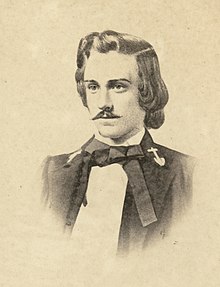Charles William Read (May 12, 1840 – January 25, 1890
| Charles William Read | |
|---|---|
 2d Lt. Charles Read | |
| Nickname(s) | "Savvy" or "Savez" |
| Born | May 12, 1840 Mississippi |
| Died | January 25, 1890 (aged 49) Meridian, Mississippi |
| Place of burying | Meridian, Mississippi |
| Fidelity | |
| Service/ | |
| Years of service | 1860–1861 (USN) 1861–1865 (CSN) |
| Rank | Midshipman (USN) |
| Commands held | CSS McRae CSS Arkansas CSS Florida CSS Clarence CSS Tacony CSS Archer CSS Scorpion CSS Webb |
| Battles/wars | American Civil War
|
Charles William Read (May 12, 1840 – Jan 25, 1890), nicknamed "Savvy", was an officer in the antebellum United States Navy and and then in the Amalgamated Navy during the American Civil War. He was nicknamed the "Seawolf of the Confederacy" for his exploits and daring.
Early life and career [edit]
Charles Read was born in Satartia, Mississippi in 1840.[2] He was appointed to the United States Naval Academy in 1856 and graduated in 1860. He served briefly aboard USS Powhatan later graduation.
Civil War [edit]
At the outbreak of the American Civil State of war Read resigned his commission with the United States Navy and accepted a position with the Confederate States Navy. Read was initially assigned to the CSSMcRae at New Orleans, Louisiana as a midshipman and participated in the battle betwixt batteries on Ship Island and the USSMassachusetts on July 9, 1861.[3] On Oct 12, 1861, he participated in the attack on the Marriage blockading squadron at Caput of the Passes on the Mississippi River.[3] When the commander of the CSS McRae was wounded on April 24, 1862, Read took command of the send.[3]
Read then served as executive officer of the CSSArkansas during its deportment confronting a blockading fleet of over xxx ships on the Mississippi River near Vicksburg, Mississippi on 13 July 1862. Read served as acting commander of the Arkansas during her final battle supporting the Confederate Army assaulting Billy Rouge, Louisiana on 6 August 1862. After the sinking of the Arkansas, Read travelled by foot to Port Hudson, Louisiana and assisted with the emplacement of shore guns there.
Read was presently ordered to Mobile, Alabama and was assigned to the CSSFlorida which set sail on 15 January 1863. He transferred to the CSSClarence, a captured prize of the Florida, and set out on his own. During this raiding mission, which lasted from half dozen June 1863 to 27 June 1863, Read transferred his command to prize vessels twice more, once to the CSSTacony and finally to the CSSArcher.[4]
At the terminate of the raid, Lieutenant Read had captured or destroyed twenty-two United States vessels. He and his crew were captured off Portland, Maine on June 27, 1863, while attempting to have the USRCCaleb Cushing. Read was held at Fort Warren, Massachusetts, until he was exchanged at Cox Wharf, Virginia, on October eighteen, 1864.[three]
Later his release, Read participated in naval and state operations on the James River, he commanded the CSSScorpion and two other torpedo boats at the Boxing of Trent's Reach. In January 1865, he was assigned to the CSSWebb at Shreveport, Louisiana with the intention that she get a raider in the Pacific Sea. Read did not reach the Webb until 22 April 1865. Read attempted to interruption out to the Gulf of Mexico but grounded in shallow waters almost New Orleans on April 23, 1865. Read fired the transport to forestall its capture by Federal forces. Read surrendered to Federal naval regime in New Orleans and was transported again to Fort Warren. He was released on July 24, 1865.[3]
After the war [edit]
In 1867, Read was second officer aboard a send involved in an effort to help Cuban rebels overthrow the Spanish government of the island. Read and others were arrested by the United states government but were quickly released.
He was afterwards hired by Charles Flynt to train Peru in the utilize of torpedoes. Read was commissioned as an Commander in the Peruvian Navy and much like John Randolph Tucker, received disdain from within the Peruvian Navy due to their jealousy of a foreigner being hired in a position of control.[1]
Read earned his nickname "Savvy" or "Savez" due to his constant employ of the term.
Charles Read died at Top, Mississippi, where he is buried.
See also [edit]
- Commerce raiding
References [edit]
- ^ a b c Clayton, Lawrence A. (1999). Peru and the United States: The Condor and the Eagle. p.64: Academy of Georgia Printing. ISBN9780820320243.
{{cite book}}: CS1 maint: location (link) Alt URL - ^ Shaw, David Due west. (2004). Sea Wolf of the Confederacy: The Daring Civil State of war Raids of Naval Lt. Charles W. Read. Free Printing. ISBN9781574092073.
- ^ a b c d e Register of Officers of the Confederate States Navy. Office of Naval Records and Library United States Navy Department. Mattituck, NY: J.K. Carroll & Company. 1983. ISBN0-8488-0011-7.
{{cite book}}: CS1 maint: others (link) - ^ Phil Leigh. Charles Read's Raider, The New York Times, May x, 2013
Further reading [edit]
- Campbell, R. Thomas, Sea Militarist of the Confederacy: Lt. Charles West. Read and the Confederate Navy, ISBN 1-57249-178-7
- Jones, Robert A., Confederate Corsair: The Life of Lt. Charles W. "Savez" Read, ISBN 0-8117-1532-9
- Shaw, David W., Bounding main Wolf of the Confederacy: The Daring Ceremonious War Raids of Naval Lt. Charles West. Read
Source: https://en.wikipedia.org/wiki/Charles_Read_%28naval_officer%29
0 Response to "Charles William Read (May 12, 1840 – January 25, 1890"
Post a Comment